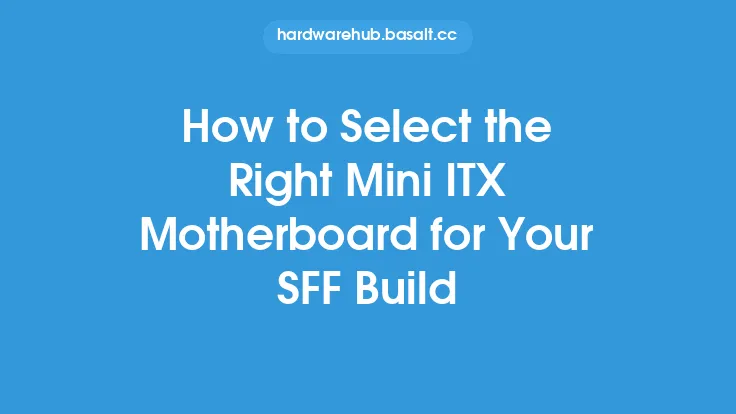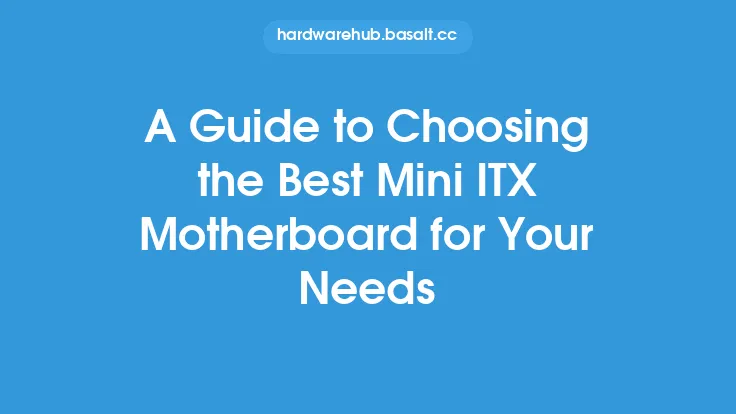When it comes to building a compact computer system, one of the most critical components to consider is the motherboard. Mini ITX motherboards, in particular, have gained popularity in recent years due to their small form factor and versatility. However, with so many options available in the market, choosing the right Mini ITX motherboard for your next build can be a daunting task. In this article, we will delve into the key factors to consider when buying a Mini ITX motherboard, ensuring that you make an informed decision for your specific needs.
Introduction to Mini ITX Motherboards
Mini ITX motherboards are designed to be compact, measuring 6.7 inches by 6.7 inches (17 cm x 17 cm). This small form factor makes them ideal for building small form factor (SFF) systems, such as home theater PCs, gaming consoles, and industrial computers. Despite their compact size, Mini ITX motherboards offer a wide range of features and functionalities, including support for various processors, memory types, and storage options. When selecting a Mini ITX motherboard, it's essential to consider the specific requirements of your build, including the type of processor, memory, and storage you plan to use.
Processor Compatibility
One of the most critical factors to consider when buying a Mini ITX motherboard is processor compatibility. Mini ITX motherboards support a wide range of processors, including Intel Core series, AMD Ryzen series, and ARM-based processors. When selecting a motherboard, ensure that it supports your chosen processor and that the socket type matches. For example, if you plan to use an Intel Core i5 processor, look for a motherboard with an LGA 1200 socket. Additionally, consider the power delivery system of the motherboard, as it should be able to handle the power requirements of your processor.
Memory and Storage Options
Another crucial aspect to consider is the memory and storage options available on the motherboard. Mini ITX motherboards typically have two or four DIMM slots, supporting up to 64 GB of DDR4 memory. However, some high-end motherboards may support up to 128 GB of DDR4 memory or even DDR5 memory. When it comes to storage, Mini ITX motherboards often have multiple SATA ports, M.2 slots, and PCIe slots. Consider the type and number of storage devices you plan to use, including hard drives, solid-state drives, and NVMe drives. Ensure that the motherboard has sufficient storage options to meet your needs.
Expansion and Connectivity Options
Expansion and connectivity options are also essential considerations when buying a Mini ITX motherboard. These motherboards often have limited expansion slots, typically one or two PCIe x16 slots, and may lack features like Wi-Fi, Bluetooth, or high-quality audio. However, some motherboards may have additional features like USB 3.2 Gen 2, USB-C, or high-speed Ethernet. Consider the peripherals and devices you plan to connect to your system, including graphics cards, sound cards, and networking devices. Ensure that the motherboard has sufficient expansion and connectivity options to meet your needs.
Power Delivery and Cooling
Power delivery and cooling are critical aspects of any computer system, and Mini ITX motherboards are no exception. These motherboards often have limited power delivery options, typically a single 24-pin ATX power connector and a few fan headers. However, some high-end motherboards may have additional power phases, improved voltage regulation, or advanced cooling systems. Consider the power requirements of your system, including the processor, memory, and storage devices. Ensure that the motherboard has a sufficient power delivery system to meet your needs, and consider additional cooling options like liquid cooling or advanced air cooling systems.
Form Factor and Case Compatibility
Finally, consider the form factor and case compatibility of the Mini ITX motherboard. These motherboards are designed to fit into small form factor cases, but ensure that the motherboard is compatible with your chosen case. Consider the mounting holes, stand-offs, and cable management options available on the motherboard and case. Ensure that the motherboard fits snugly into the case and that all cables can be managed efficiently.
Conclusion
In conclusion, buying a Mini ITX motherboard requires careful consideration of several key factors, including processor compatibility, memory and storage options, expansion and connectivity options, power delivery and cooling, and form factor and case compatibility. By understanding these factors and selecting a motherboard that meets your specific needs, you can build a compact and powerful computer system that meets your requirements. Whether you're building a home theater PC, a gaming console, or an industrial computer, a Mini ITX motherboard can provide the perfect balance of performance, features, and compactness.





